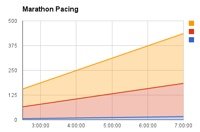The 5 Hour Marathon Runner Race Strategy
The objective of the marathon runner race strategy is to finish a marathon within 5 hours. To do this, you'll need to run a majority (75% or more) of the marathon. This is a great strategy for new runners who are adequately prepared, experienced athletes who have had limited preparation, and the slow but steady runners.

To start, let's look at the basics of this strategy. To complete a marathon in 5 hours, you'll need a mile average of 11 minutes and 27 seconds. That's a fairly easy jogging pace for most people. The difficulty comes in maintaining that pace for all 26.2 miles.
The average 5 hour marathon finisher runs the first 13.1 miles about 20 minutes faster than the last 13.1 miles. This is quite a difference between the halves. It's the run faster and fade later strategy. A more optimal strategy is to run a bit slower in the beginning and save more for the last half. Instead of fading and feeling awful in the last half, our 5 hour strategy will be more balanced.
The first half of the strategy is to run 12 minutes faster than the last half. This means we're aiming for 2:24 in the front and 2:36 in the last half. Taking that in mind, we've divided the marathon into four parts: pre-race preparation, miles 0 -13.1, miles 13.1 - 20, miles 20 - 26.2.
Part 1: Miles 0 - 13.1
Read the Marathon Pre-Race Checklist and come back for the start of the race.
Blister Treatment for Marathoners
We're going to cover the first half-marathon in this part. For an experienced runner or a new runner that is well-trained, going 13.1 miles should be a fairly easy distance. The key is to hold back a bit. You don't want to try and set a PR (personal record) for the half while doing a full! Our goal is to run this in 2:24, which means you'll need to average 11 minute miles for the first half.
There are a couple of ways to run 11 minute miles. Run continuously, or run a bit faster with a short walking break in each mile. It's up to you at this stage in the race. Walking some early can help "save the legs" for later in the race. A run/walk strategy would be to run for 10 minutes and then walk the last minute in to each mile marker.
Depending on the temperature, you'll want to try and drink something about every 2 miles. If it's cold, this may be a sip or two, and if it's hot, it may be a whole cup full. The rule of thumb is "If you're thirsty, drink!". Your body has evolved over millions of years to relay reliable thirst information to you, listen to it, and don't try to overthink it. This means don't chug water if you don't feel like it.

Full-calorie sports drink and a bit of food (fruit, gels, candy, etc) is also a good idea. It'll help with your body's energy needs. You don't want to overdo it, however, aim for 100-200 calories per hour. More than that and your stomach may reject you!
Here are some notable points for time in this part:
- 3 miles: 33 minutes
- 5 miles: 55 minutes
- 10 miles: 1:50
- 12 miles: 2:12
- 13.1 miles: 2:24
Once you reach the half way point, you should feel good. You might be getting just a tiny bit tired, but that's normal. Hopefully your body is holding up well. Minor aches and pains are normal. Any major pain is something to be concerned about.
If your range is 2:19-2:27, you're ok time-wise. If you are much faster than 2:19, you're either: 1) a faster runner than a 5 hour marathoner, or 2) a 5 hour marathoner that has gone out too fast. If you're #1, then you're great, keep it up and go for a great time. If you're #2, and you're starting to really feel the miles, you're going to need to reign it in, and definitely put in some walking breaks in the next part.
Part 2: Miles 13.1 - 20
We're now getting into the more challenging part of the marathon, the back half. This is what most marathoners run for! Although the second half is the same distance as the first half, it's at least twice more difficult. We've purposely held back at this point to save energy for the remainder.
We're going to slow just a bit from our previous pace, down to 11 minutes and 20 seconds per mile. It's a good idea in this part to take at least 3 walking breaks, just to give your legs and body a chance to downshift a bit. A good place to walk is through the water stations.
If you've been drinking a lot of water, you may want to change to a sports drink to help replenish your electrolytes. Another option is to eat salty food (potato chips, pretzels), use a gel with electrolytes in it, or take a salt pill. If you haven't taken in any calories, now is a good time. The infamous wall is approaching and you don't want to hit it.
Great Products to Replenish Electrolytes
GU Energy Gel SaltStick Electrolyte Tabs GU Brew Drink Tablets
Your feet may be getting sensitive, hot spots, and even blisters at this point. Hop over to our article on blister treatment to get a run down on how to handle it.
Assuming that you've reached the half-way point at 2:24, here are some notable times to reach mile markers:
- Mile 16: 2:57
- Mile 19: 3:31
- Mile 20: 3:42
Part 3: Miles 20 - 26.2
Hitting mile 20 at 3 hours and 42 minutes will give you 1 hour and 18 minutes to cover 6.2 miles. That gives you a bit of buffer to run the rest of the race at a slower pace. If you're much over 3 hours and 50 minutes at mile 20, hopefully you're feeling decent, and can continue to push the pace. If you're much faster than 3:42, keep it going, you have a good chance to be well under a 5 hour marathon.

An hour and 18 minutes for 6.2 miles gives you an average mile time of about 12 min 34 secs. We'll aim for 12 minute miles, just to give a bit of buffer to make it in before the 5 hour mark.
After 20 miles, your body is likely hurting some. Your large leg muscles may be cramping a bit. You may have some aches and pains in places you didn't know existed. That's ok. Pain at this point is normal. Searing, excruciating pain is not. If something is absolutely hurting more than you ever thought possible, try to find a medical station to get checked out. The most common major injuries in a marathon are stress fractures, muscle tears, and tendon tears. Finishing a race with a major injury is foolish, as you'll just make the problem worse and have a longer recovery time.
At our 12 minute pacing goal per mile, however you want to do it is your perogative. A good method is to run for 5 minutes, walk for 1 minute, run for 5 minutes, and then walk the last minute into each mile marker. Using this 5/1/5/1 approach, aim to run at 11 min/mile pace during the run portions, and walk briskly (over 20 min/mile or 3 mph). Again, time your walks through water stations.
Here's the mile by mile final breakdown:
- Mile 21 - 3:54
- Mile 22 - 4:06
- Mile 23 - 4:18
- Mile 24 - 4:30
- Mile 25 - 4:42
- Mile 26 - 4:54
- Finish - 4:56 (4 minutes to spare!)
Consider the 5 hours to be a good goal, but if you don't quite make the time, be happy that you completed the race. Good luck on your marathon and enjoy the journey!




